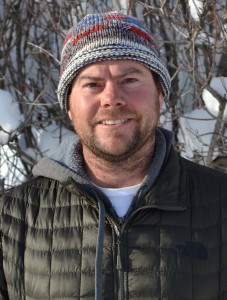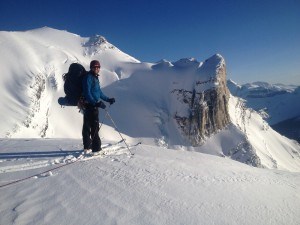
There’s no such thing as a typical day in the life of a mountain guide. At least according to Jasper-based mountain guide Matt Reynolds.
During the course of a year, he goes from leading small groups up some of the region’s biggest mountains, to writing avalanche safety plans to teaching kids how to rock climb, and just about every mountain-related thing in between. Those jobs can come from private groups, industry, the Canadian government and universities.
Two weeks ago, on Jan. 23, he was in the middle of a five-day traverse of the Wapta Icefields, training a group of Search and Rescue Technician (SAR Tech) students from the Canadian Military.
Many of the students had little or no experience on skis, and Reynolds and another guide were giving them a crash course on severe mountain conditions. To do that, they stepped back and allowed the students to be the navigators.
They had set out Jan. 20, spending three days trekking to Balfour Hut. On Jan. 23 they were set to head back to Bow Hut for the night, but awoke to a blizzard and whiteout conditions.
The trek from Balfour to Bow is an involved one, with some challenging routes that would, even on a good day, test any beginner. The white-out added a whole new layer to the challenge.
“Typically in guiding, its easy enough with the training to take a group through any conditions. With the SAR Techs it’s a little different. It’s a training program so you’re teaching them how to cope with all those conditions,” Reynolds said in an interview Feb. 3.
Reynolds explained that to leave Balfour Hut they had to get through the moraines, rocks and cliffs and up onto the nearby glacier. From there they would cross a high pass, and descend across a flat glacier to Bow Hut.
“It’s tricky navigation, because there are crevasses, and there are certain places you wouldn’t want to be,” he explained.
On that day it was even worse, because the conditions killed all visibility, making it difficult to know where they were going. Reynolds knew he had his work cut out for him getting his students through the blizzard.
Travelling in the mountains in bad conditions forces a person to rely on the terrain around them to navigate. But on wide open glaciers, like the one they would be traversing that day, those features aren’t close enough to be of any real value.
“Without the terrain features it’s like being inside a ping-pong ball,” explained Reynolds. “If you’re going downhill you have a really hard time orienting yourself. There’s times where I’ve actually just fallen over being completely stationary because I thought I was moving. In those conditions it’s very challenging to keep yourself moving forward and in the same direction.”

By 8:30 a.m. the group set out, and it didn’t take long for them to get off-track. Reynolds explained that a few small mistakes are good because they provide valuable learning experiences for the students, but it would be irresponsible and dangerous to let them get too far afield.
“You don’t want them to make the wrong decision at the wrong time,” he explained. “So you want to let them make some small mistakes so they can learn from them, but you have to really be careful with where they’re taking you and what their plans are for how to move forward.”
That morning, from his position at the back of the group, he realized his charges were relying too heavily on the GPS, taking its straight-line directions from one point to the other, and not paying enough attention to their map and the surrounding terrain.
Once he saw them heading into steeper, more dangerous areas, where potential crevasses and avalanches lurked, he had to step in and get them back on track.
It sounds like an easy decision to make, but Reynolds, like all mountain guides certified through the Association of Canadian Mountain Guides, had years of experience and training to guide him.
The certification process is a series of five intense exams, with tons of practical experience required between each. It typically takes people at least five years to finish.
Reynolds said that he had been interested in mountaineering since his early teens, but it took him almost a decade before he even had enough personal experience just to start the exam process.
He passed his first exam in 1997, and passed and failed a long list of exams on his way to becoming a fully certified guide in 2009.
He guessed that there are still less than 200 fully certified guides in Canada, because it takes such dedication and commitment to make it all the way through the process.
So knowing exactly when to jump in and help his students, or the best way to navigate a tricky route, is a decision backed by almost an entire lifetime of experience and training.
Reynolds said that’s one of the reasons why the certification program is as difficult and involved as it is: mountain guides have to have the ability to handle really stressful situations.
“It’s not a job for the faint of heart, that’s for sure. Because you’re often in very uncomfortable situations, and as a guide you have to be the one with the cool head to make sure all the decisions that are being made are appropriate.
“It’s very easy for things to go wrong, and unlike most jobs the consequences can be quite severe. We are talking about life and limb, there is a lot of responsibility that goes along with it,” he said.
On Jan. 23, after he helped the SAR Techs get to the high pass, they began the slow descent to Bow Hut, arriving by 5 p.m.
Once inside and comfortable, Reynolds gave the students a rundown of the finer points of crevasse rescue, before facilitating a debrief, pointing out the important developments of that day’s tour.
Then they all went to bed, woke up the next morning and did it all again the following day.
Reynolds said that few jobs prepare a person to face the world, both emotionally and physically, as much as mountain guiding. It can be both brutally difficult and incredibly rewarding, and he said that’s why he loves it so much.
“It’s a funny job, the good days are great, it doesn’t feel like you’re working at all, and the bad days can be very bad: it can be very stressful and not a whole lot of fun. But you get paid for both, and that’s part of the job description.”
Trevor Nichols
[email protected]
